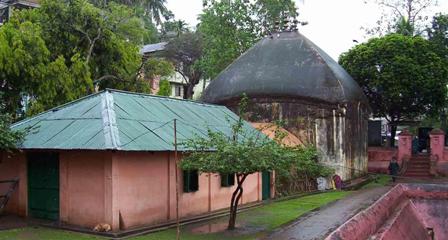History & Heritage

Archaeologically drawn traces indicate existence at Rajaduar, of Kamrup Nagar. The capital city Durjaya established by the powerful Pala kings, until 1260 A.D. when the capital was shifted to Karnatapur in North Bengal. There is little doubt that the pre-historic capital city Pragjyotishpur of the demon kings Narakasur and the Mahabharata-famed Bhagadatta had included the north bank of the Brahmaputra from the present dirgheswari hillock to Agiya-thori, along with the south bank from Gonesh Guri to Fata-Shill, in Guwahati metropoly.
King Parikshit Narayan, a descendent of the great Koch king Maharaj Naranarayan, whose territories included the districts Darrang, and undivided Kamrup and the undivided Goalpara up to the foothills of the Gar-Range in Meghalaya, set up his capital on the northen side of the Aswakanta hillock in the year 1603 AD. This site is only about two kilometers away to the west of Rajadooar.
Defence-strategy compulsions made the medieval kings of Kamrupa, i.e. ancient Assam to have their military headquarters established at North Guwahati for its natural advantage. This necessity was felt more by the Ahoms when they extended their rule to Guwahati with the viceregal officer, designated as Barphokan posted here, though their capital was still in the upper Assam district of Sibsagar. The Barpokhan resisted the Mughal onslaughts with fortification of Rajadooar and the adjoining country side upto the hillocks Chila. Agia thuri, about five kilometers away to the west. The historical battle of Soraighat testified efficiancy of these measures. The Ahom general Lachit Barpokhan demonstrated his valour, despite his bed-ridden illness, by not only beating the Mughals, but also driving them away to the other side of the river Manas, a tributory of the Brahmaputra, which is the western boundary of the undivided district of Kamrup.
It was perhaps during military preparations made by the great Ahom king Rudra Singha against the Mughals that this post of the north bank i.e. present North Guwahati came to be identified as Rajadooar, the king's gateway. For the king could reach the Brahmaputra for any naval journey from his pleasure house Rang Mohal, about three kilometers to the north of the river, only by the pass cut-out as the gate-way, between the hillocks Monikarneswar and Chandra-Bharati Mandap. This is the road taken by the devotees of Lord Doul-Govinda and other members of the public to and from the ferry-approach on the north bank.
The hillock of Manikarneswar stands at the extreme east at the confluence of the tributory of the Brahmaputra where the river is in spate during the rainy season. Barnadi as a natural spur against the fury of the hillock, Manikarneswar extends its tailbone to the the north-east direction to reach the KANAIBARS HI- BOWA SHEE, which is a huge rock said to have served KANA! (SHRI KRISHNA) as the seat for angling in the river. This site is only three minutes walk from the temple premises. The recently established Anunda Ram Barooah institute of Language Art & Culture' is located close to this rock. This rock of unusual size bears evidence of the military might of this land in a two-line script engraved thereon in local characters in their formative stage, which renders as below: "The Turkis came to Kamarupa and got perished at this spot in the year 1206 AD". This rock witnessed the victory of the local kings against the Moghul aggressors in the first battle on the Barnadi, Two Mohammadan officers Sayed Chana and Sayed Firoz were taken prisoners and slain by the Ahom generals, the Buragohain (minister) and Barpukhan (Vice-Roy) in co-operation with two other Ahom high-ups and subsequently they got the Rangmohal-garh (rampart) constructed along the bank of rivulet Fulung since dried up, to the foot hills of Dirgheswary hills. This old rampart (Garh) has served North Guwahati and the adjoining villages as an embankment-cum-road till this date.